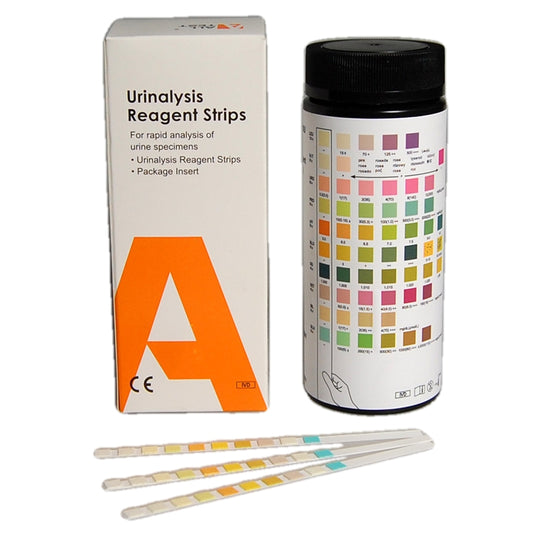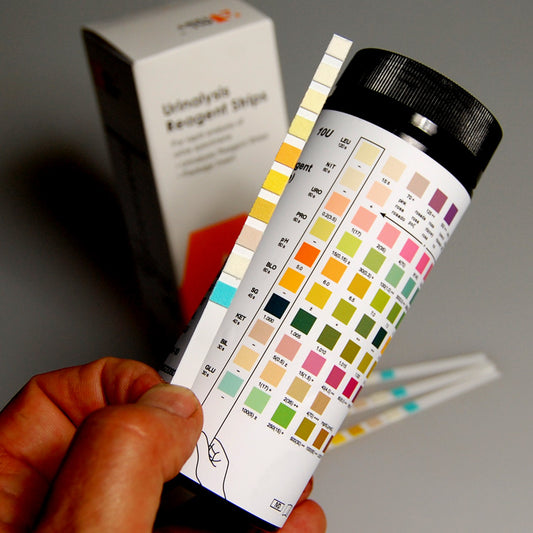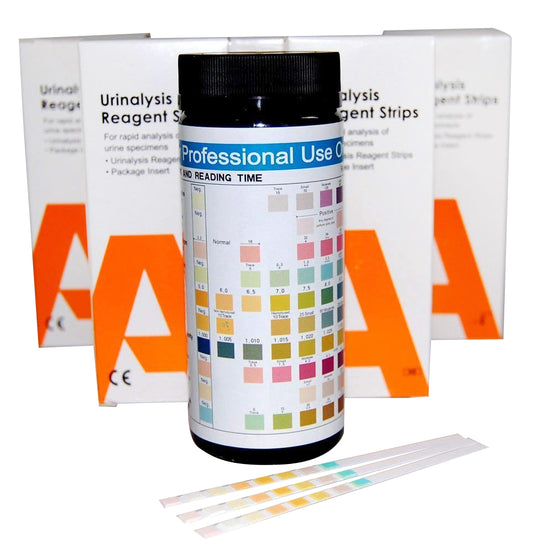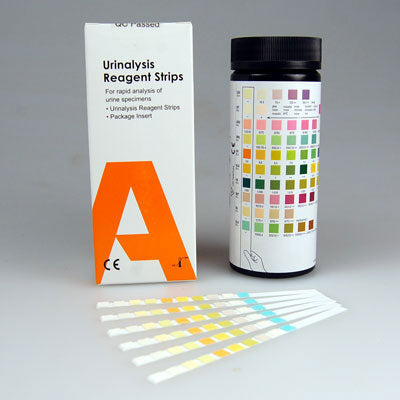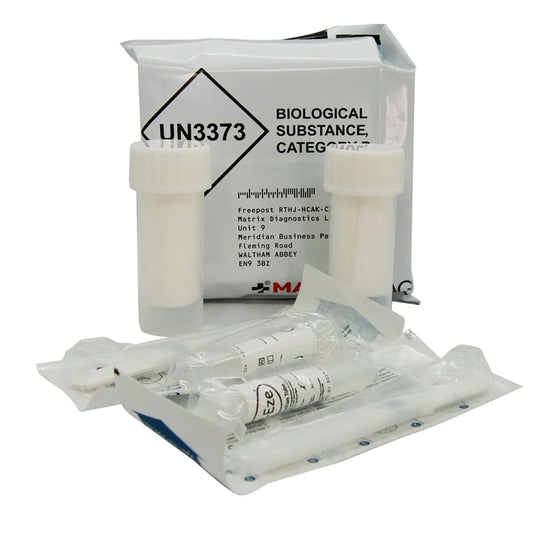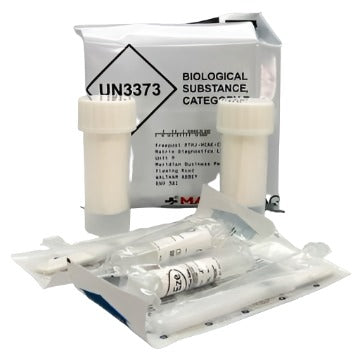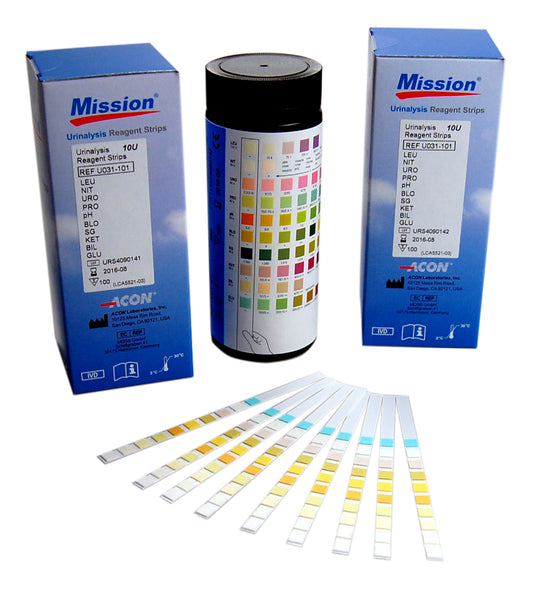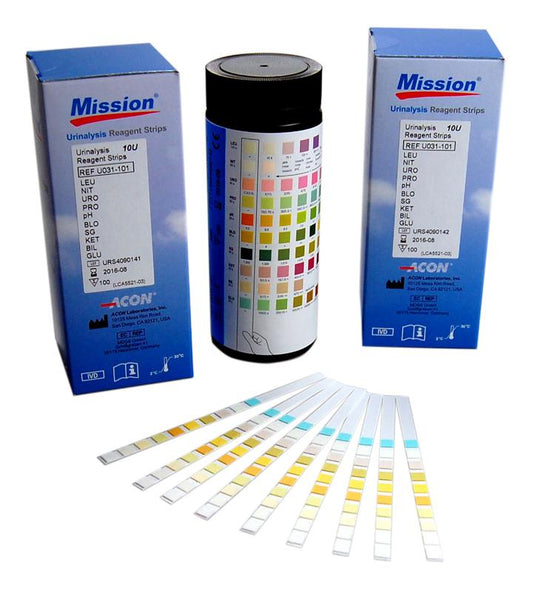Collection: 10 Parameter Urine Test Strips
-
ALLTEST 10 Parameter URS10 Urinalysis Urine Test Strips Pack of 100 test strips
12 reviewsRegular price £7.75 GBPRegular priceUnit price / per -
Wholesale ALLTEST URS 10 Parameter Urine Test Strips Pack of 100
No reviewsRegular price From £347.50 GBPRegular priceUnit price / per -


VECHEK 11 Parameter Urine Test Strips For Vets And Pets URS Pot Of 25 Urine Strips Special Offer
2 reviewsRegular price £2.95 GBPRegular priceUnit price / per£5.95 GBPSale price £2.95 GBPSale -
Workplace Saliva GC/MS Laboratory Confirmation Drug Test Pack (£66 per single drug)
No reviewsRegular price £66.00 GBPRegular priceUnit price / per -
MISSION 10 Parameter Urine Test Strips Pack of 100 URS10U
2 reviewsRegular price £8.99 GBPRegular priceUnit price / per -
Wholesale MISSION 10 Parameter Urine Test Strips Pack of 100
No reviewsRegular price From £425.00 GBPRegular priceUnit price / per
10 parameter urinalysis urine test strips
10 Parameter test strips are quick and simple dipstick urine test that tests for 10 parameters in a urine sample. These urine dipping sticks are widely used by healthcare professionals and by GPs to screen for urine infections, UTI and other health conditions. They can also be suitable for self-testing for urinary tract infections and cystitis.

Each 10 parameter test strip tests urine for the following 10 things:
- Glucose
- Ketones
- Specific Gravity
- Blood
- pH
- Protein
- Nitrite
- Bilirubin
- Urobilinogen
- Leucocytes (white blood cells)
10 parameter urine test strips for urinalysis

How to Use 10-Parameter Urine Test Strips
Urine test strips, also known as urinalysis test strips and urine dipping sticks, are valuable tools for monitoring your health and can provide insights into various aspects of your well-being. A 10-parameter urine test strip is particularly versatile, as it measures ten different components in your urine, allowing you to assess multiple aspects of your health at once.
Here's a step-by-step guide on how to use these urine test strips effectively:
1. Gather Your Supplies:
- 10-parameter urine test strips
- A clean, dry container for urine collection
- A timer or watch, you can use timer on your phone or smart watch
- Gloves should be worn if the urine test is being conducted in a clinical setting
2. Wash Your Hands: Before handling the test strips or collecting urine, make sure to wash your hands thoroughly with soap and water to prevent contamination.
3. Collect a Urine Sample:
- Use a clean and dry container to collect a fresh urine sample.
- The test can be used at any time of day but the best time to collect urine is in the morning when it's most concentrated.
4. Dip the Test Strip:
- Remove a 10-parameter urine test strip from its packaging.
- Immerse the test strip completely into the urine sample for about 1-2 seconds, making sure all the reagent pads ( the coloured pads) are submerged.
5. Remove Excess Urine:
- Gently tap the strip against the edge of the urine container to remove any excess urine.
- Be careful not to touch the reagent pads with your fingers.
6. Wait for Reaction:
- Lay the test strip flat on a clean, dry surface.
- Start a timer for the recommended reaction time, which is usually around 60 seconds. Follow the instructions provided with the 10 parameter urine test strips for precise timing.
7. Interpret the Results:
- After the designated time, compare the colours on the test strip's reagent pads to the color chart provided on the strip's packaging or in the accompanying instructions.
- Match the colours as closely as possible to determine the concentration of various parameters in your urine, such as pH, glucose, protein, ketones, and more.
- Each parameter will have its own corresponding color block on the chart.
8. Record Your Findings:
- Make note of the results for each parameter tested.
- If you have any concerns or if the results are outside the normal range, consult a healthcare professional for further guidance.
9. Dispose of the Test Strip and reseal the pot:
- Safely dispose of the used test strip as per local regulations.
- Make sure you replace the lid on the pot as soon as you finish using them and screw it on tightly to preserve the rest of the test strips. If the lid is left off moisture may enter the pot and damage the other strips.
You may also find this post on what do urine test strips detect helpful
What do the results of the 10 parameter urine test indicate?
Glucose typically doesn't appear in urine under normal circumstances. When it does, it serves as an indicator of elevated blood glucose levels, insulin resistance, and the potential onset of diabetes. This progression usually spans several years before symptoms prompt further investigation. Detecting glucose in an asymptomatic patient's urine screening can help mitigate complications and risks to vital organs that may arise prior to a symptomatic diagnosis.
Ketone bodies in urine can also serve as a diabetes marker, particularly in cases of ketoacidosis associated with very high glucose levels. While ketones can still indicate poorly controlled diabetes, real-time measurement using blood test strips has largely replaced urine ketone testing. Nowadays, urine ketones are of more interest to individuals following a low-carb, high-fat diet, such as the classic ketogenic diet, as a marker of carbohydrate restriction.
Discovering blood in urine is always concerning. Urine test strips offer high sensitivity, enabling the detection of microscopic levels that are invisible to the naked eye. This condition is medically referred to as "microscopic hematuria." The least worrisome cause of blood in the urine is a urinary tract infection, which can manifest distally (as in urethritis or an STD), in the bladder (as in cystitis), or in the kidneys (as in kidney infection or pyelonephritis). Other potential causes encompass renal stones, post-medical procedures, renal tumors, bladder polyps, or trauma. An exception to this if if a woman is menstruating blood will quite likely be detected in the urine. In that case the test should be repeated when the period is completely over.
Proteins should typically not be present in urine. Causes of their presence include infections and renal diseases. In some rare metabolic conditions, excessive abnormal protein strands are excreted into the urine. If proteins are detected without concurrent positive findings of blood or leukocytes in the same sample, it may suggest renal disease or "leaky" kidneys.
The presence of leukocytes or white blood cells in urine indicates an infection within the renal tract. It serves as a pivotal marker for infection and is often accompanied by positive nitrite and protein tests. In severe cases, blood may also be detected in the same sample.
Specific gravity reflects the concentration of a urine sample, which can vary significantly over a 24-hour period depending on fluid intake. Thus, it is not an exceedingly specific marker but aids in result interpretation by indicating whether the sample is diluted or concentrated. It can serve as an indicator of dehydration.
pH levels, which indicate acidity, can also hint at metabolic conditions or renal disease, including kidney stones. Dietary factors can also influence urine pH. A typical urine pH falls between 4.8 and 8.1.
Nitrite, a breakdown product of nitrates by bacteria, indicates infection when it tests positive. It is a critical indicator for renal tract infections, often coinciding with the presence of blood and leukocytes.
Bilirubin is typically absent in urine and suggests liver disease when detected. Bilirubin often causes yellow discoloration in the whites of the eyes before clinical jaundice becomes evident. Liver conditions like cirrhosis and liver failure can elevate bilirubin levels. Additionally, blood disorders with high cell turnover and breakdown can overwhelm the liver, leading to increased bilirubin levels in both blood and urine.
Urobilinogen is normally present in trace amounts in urine. However, levels exceeding 0.2mg/dl indicate that bilirubin is being broken down in the gut. This, too, serves as an indicator of liver disease or blood disorders characterized by rapid cell degradation.
Remember that while urine test strips can provide valuable insights into your health, they are not a substitute for professional medical advice. If you have specific health concerns or receive abnormal results, it's essential to consult a healthcare provider for a thorough evaluation and appropriate guidance. Regular monitoring of your health using urine test strips can be a helpful tool in maintaining your well-being and catching potential issues early on.
Brands of URS10 10 parameter test strips available:
- ALLTEST URS10
- URS 10U from Mission
Our 10 parameter urine test strips are of the highest quality, manufactured to the strictest standards to ensure accurate and reliable results. They are ideal for use in clinical settings, by healthcare providers or individuals who want to monitor their health at home. They are a powerful diagnostic tool that can provide valuable insights into a person's health.
Both brands of 10 parameter urinalysis strips are designed to detect the presence of 10 different parameters in urine samples, including glucose, ketones, protein, nitrites, leukocytes, pH, blood, specific gravity, urobilinogen, and bilirubin. This comprehensive testing can help detect a range of medical conditions, such as urinary tract infections, diabetes, liver disease, and kidney problems. The test strips are very easy to use and read , with results available in just a few minutes.
Wholesale 10 Parameter Urine Test Strips
At Valuemed, we also offer these urine testing strips in bulk quantities, making them an affordable and convenient choice for healthcare practices, clinics, and hospitals. We also offer fast shipping and responsive customer service to ensure your satisfaction with our products. Invest in our 10 parameter urine test strips to help detect and monitor a range of medical conditions and take control of your health today.

